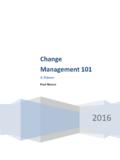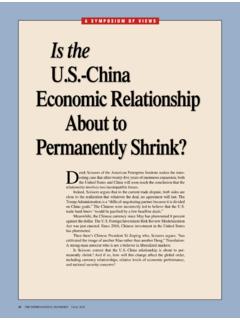Transcription of Literature review: Understanding how to improve the ...
1 Health and Safety Executive Literature review: Understanding how to improve the management of exposure to wood dust amongst construction sub-contractors and manufacturing SMEs Prepared by the Health and Safety Laboratory for the Health and Safety Executive 2014. RR1017. Research Report Health and Safety Executive Literature review: Understanding how to improve the management of exposure to wood dust amongst construction sub-contractors and manufacturing SMEs Dr Chrysanthi Lekka CPsychol CSci and Victoria Bennett CPsychol Health and Safety Laboratory Harpur Hill Buxton Derbyshire SK17 9JN. Available evidence was reviewed to develop a better Understanding of how to improve the management of wood dust exposure in small and medium-sized construction and manufacturing enterprises (SMEs).
2 There was a paucity of research, with most papers exploring the factors that broadly influence health and safety (H&S) management in SMEs. Factors that influence SMEs' behaviours, included: i) limited resources (particularly for small construction and wood working companies), ii) a poor awareness of the importance of ill-health prevention, iii) risk control advice from third parties, iv) management/peer H&S attitudes, and v) negative attitudes towards risk controls. Higher levels of H&S awareness and better training provisions were some of the most noteworthy differences found in large compared to small construction companies.
3 Lone working and managing a transient workforce were challenges identified for woodworking and large construction companies respectively. This report and the work it describes were funded by the Health and Safety Executive (HSE). Its contents, including any opinions and/or conclusions expressed, are those of the authors alone and do not necessarily reflect HSE policy. HSE Books Crown copyright 2014. First published 2014. You may reuse this information (not including logos) free of charge in any format or medium, under the terms of the Open Government Licence. To view the licence visit , write to the Information Policy Team, The National Archives, Kew, London TW9 4DU, or email Some images and illustrations may not be owned by the Crown so cannot be reproduced without permission of the copyright owner.
4 Enquiries should be sent to ii CONTENTS. 1 INTRODUCTION AND METHOD .. 1 Background and research aim .. 1 Methodology .. 1 2 FINDINGS .. 2 Factors influencing SME behaviour: Cross-cutting themes .. 2 Approaches to behaviour change in SMEs .. 4 3 7 Research caveats .. 7 Issues for consideration .. 8 4 9 5 APPENDICES .. 10 Appendix 1: Literature search .. 10 Appendix 2: HSL's Make it Happen model' .. 11 Appendix 3: Summary of findings using the Make it happen' model .. 12 iii SUMMARY. Available evidence was reviewed to develop a better Understanding of how to improve the management of wood dust exposure in small and medium-sized construction and manufacturing enterprises (SMEs).
5 There was a paucity of research with most papers exploring the factors that broadly influence health and safety (H&S) management in SMEs. Fifteen papers were reviewed and the findings were mapped onto the Health and Safety Laboratory's (HSL) Make it happen'. model of behaviour change, which specifies the physical, social and individual factors that influence behaviour. Factors that influence SMEs' behaviours, included: i) limited resources (particularly for small construction and wood working companies), ii) a poor awareness of the importance of ill-health prevention, iii) risk control advice from third parties, iv) management/peer H&S attitudes, and v) negative attitudes towards risk controls.
6 Higher levels of H&S awareness and better training provisions were some of the most noteworthy differences found in large compared to small construction companies. Lone working and managing a transient workforce were challenges identified for woodworking and large construction companies respectively. Suggested approaches for improving the management of wood dust exposure included providing incentives to highlight the benefits of good H&S practices, offering practical guidance on risk controls, and using communication strategies to raise awareness about health risks amongst SMEs, including Tier 1 (large) construction companies.
7 For Tier 2 (small). construction companies and manufacturing SMEs, persuasive risk communication to raise awareness of the health risks associated with wood dust, promoting worker involvement in H&S, and helping SMEs to train their workers/supervisors about the health risks from wood dust and controls seem vital. iv 1 INTRODUCTION AND METHOD. BACKGROUND AND RESEARCH AIM. This report forms part of the wider project, which aims to generate up-to-date intelligence on occupational exposures to wood dust in the construction and manufacturing (woodworking). industries. This Literature search was carried out to develop a better Understanding of how to influence construction sub-contractors and manufacturing small and medium-sized enterprises (SMEs) to better manage worker exposure to wood dust.
8 The findings will be combined with those obtained from the next phase of the research involving telephone interviews with management/site supervisors, and assimilated into the final research report. METHODOLOGY. A total of fifteen papers were reviewed, which included HSE/HSL reports as well as published peer-reviewed papers (see Appendix 1 for further details). For each paper, relevant information was summarised using HSL's Make it happen' model (see Figure 1), which captures the key influences on risk-taking behaviour in the workplace. The model is based on an in-depth Understanding of the latest evidence from science and industry.
9 It recognises that changing behaviour in the workplace requires a multifaceted approach that tackles influences on behaviour that arise from the work context (physical and social) as well as the individual (knowledge, skills, motivation, risk appraisal, attitudes and beliefs). See Appendix 2 for more information. Figure 1 HSL's Make it Happen' model of behaviour change By using the model as a framework for organising the findings from the Literature search, it was possible to identify the areas that have received most research attention, any knowledge gaps, and the implications of the findings in terms of encouraging SMEs to better manage exposure to wood dust.
10 1. 2 FINDINGS. There was a scarcity of papers that specifically examined the management of dust exposure in the construction and/or manufacturing (woodworking) sectors. As a result, the papers included in this report explored more broadly the factors ( individual, job and organisational) that influence the management of health and safety (H&S) and/or occupational health in SMEs. In some cases, papers focused on a variety of industries. In such instances, key findings across the two sectors of interest were extracted. Two of the fifteen papers were generic focusing on the characteristics of successful interventions for managing occupational health in SMEs (Stephens et al.)













